Fisheropone ambigua
| Fisheropone ambigua | |
|---|---|

| |
| Scientific classification | |
| Kingdom: | Animalia |
| Phylum: | Arthropoda |
| Class: | Insecta |
| Order: | Hymenoptera |
| Family: | Formicidae |
| Subfamily: | Ponerinae |
| Tribe: | Ponerini |
| Genus: | Fisheropone |
| Species: | F. ambigua |
| Binomial name | |
| Fisheropone ambigua (Weber, 1942) | |
| Synonyms | |
| |
Collection records show this species inhabits a range of moist forest habitats and, with most collections having come from litter sampling, is apparently a soil or litter dwelling ant.
Identification
Weber (1942) - The thorax of this ant is like that of many Euponera species yet it has but one well-developed tibial spur on the middle and hind legs.
Distribution
Latitudinal Distribution Pattern
Latitudinal Range: 6.216667° to -25.73711°.
| North Temperate |
North Subtropical |
Tropical | South Subtropical |
South Temperate |
- Source: AntMaps
Distribution based on Regional Taxon Lists
Afrotropical Region: Gabon, South Africa, Sudan (type locality), Uganda, United Republic of Tanzania.
Distribution based on AntMaps
Distribution based on AntWeb specimens
Check data from AntWeb
Countries Occupied
| Number of countries occupied by this species based on AntWiki Regional Taxon Lists. In general, fewer countries occupied indicates a narrower range, while more countries indicates a more widespread species. |

|
Estimated Abundance
| Relative abundance based on number of AntMaps records per species (this species within the purple bar). Fewer records (to the left) indicates a less abundant/encountered species while more records (to the right) indicates more abundant/encountered species. |

|
Biology
Castes
Images from AntWeb
   
| |
| Worker. Specimen code casent0235965. Photographer Estella Ortega, uploaded by California Academy of Sciences. | Owned by AFRC, Pretoria, South Africa. |
   
| |
| Worker. Specimen code casent0289205. Photographer Cerise Chen, uploaded by California Academy of Sciences. | Owned by CAS, San Francisco, CA, USA. |
 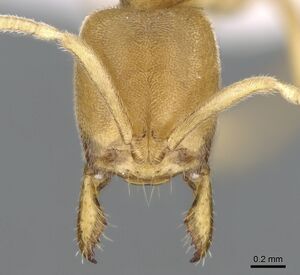   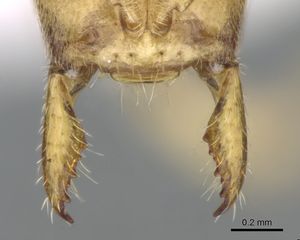 
| |
| Worker. Specimen code casent0906209. Photographer Estella Ortega, uploaded by California Academy of Sciences. | Owned by CAS, San Francisco, CA, USA. |
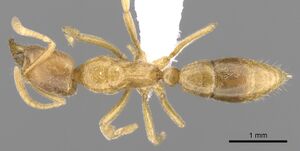  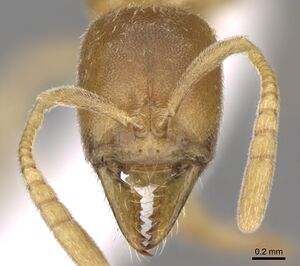   
| |
| Worker. Specimen code casent0906215. Photographer Cerise Chen, uploaded by California Academy of Sciences. | Owned by CAS, San Francisco, CA, USA. |
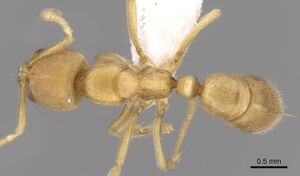    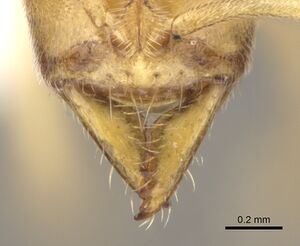 
| |
| Worker. Specimen code casent0906216. Photographer Cerise Chen, uploaded by California Academy of Sciences. | Owned by CAS, San Francisco, CA, USA. |
Nomenclature
The following information is derived from Barry Bolton's Online Catalogue of the Ants of the World.
- ambigua. Ponera ambigua Weber, 1942a: 46, fig. 6 (w.) SOUTH SUDAN.
- Type-material: holotype worker.
- Type-locality: South Sudan (“Anglo-Egyptian Sudan”): W slopes of Imatong Mts, Lotti Forest, 5.viii.1939, no. 1452 (N.A. Weber).
- Type-depository: MCZC.
- Combination in Pachycondyla: Brown, in Bolton, 1995b: 302;
- combination in Fisheropone: Schmidt, C.A. & Shattuck, 2014: 89.
- Status as species: Weber, 1943c: 300; Bernard, 1953b: 197 (in key); Bolton, 1995b: 302.
- Senior synonym of gulera Özdikmen, 2010c: 992 (unnecessary replacement name).
- Distribution: Gabon, South Sudan, Tanzania, Uganda.
- gulera. Pachycondyla gulera Özdikmen, 2010c: 992.
- Unnecessary replacement name for, hence junior synonym of, ambigua Weber, 1942a: 46.
Unless otherwise noted the text for the remainder of this section is reported from the publication that includes the original description.
Description
Worker
Length extended about 2.5 mm. (of thorax 0.75 mm.). Head in front view, excluding mandibles, 1.1 times longer than broad and rectangular with rounded corners, occipital margin impressed, sides subparallel, feebly convex, anterior clypeal margin feebly convex; frontal lobes short, convex, carinae vestigial, frontal groove deep and distinct to middle of head from which it continues faintly to occiput; eyes vestigial, in front of middle of head; mandibles elongate, trigonal, with 8 denticles of irregular development of which two are distinct, and a long, acute apical tooth; antennal scape extends approximately to a level with the occipital corners; terminal funicular joint compressed and apically blunt, 0.08 x 0.24 mm., joints 8-10 squarish. Thorax with epinotum lowered and laterally compressed as in Euponera; from above the pro- and mesonotum appear ovate in outline, the pronotum being broader than long and with all sides strongly convex except for concave surface joining mesonotum; mesoepinotal impression distinct on sides. Petiolar node from above with convex anterior surface and plane posteriorly. 1st gastric segment from above broader than long, narrowed anteriorly, 2d segment larger. Legs of moderate proportions.
Shining, finely punctate. and sparse, upright, longer brownish yellow.
Type Material
Holotype: One worker (No. 1452) taken by myself in the Lotti Forest on the west slopes of the Imatong Mts., A.-E. Sudan August 5.
References
- Esteves, F.A., Fisher, B.L. 2021. Corrieopone nouragues gen. nov., sp. nov., a new Ponerinae from French Guiana (Hymenoptera, Formicidae). ZooKeys 1074, 83–173 (doi:10.3897/zookeys.1074.75551).
- Schmidt, C.A. & Shattuck, S.O. 2014. The higher classification of the ant subfamily Ponerinae (Hymenoptera: Formicidae), with a review of ponerine ecology and behavior. Zootaxa 3817, 1–242 (doi:10.11646/zootaxa.3817.1.1).
- Weber, N. A. 1942b. New doryline, cerapachyine and ponerine ants from the Imatong Mountains, Anglo-Egyptian Sudan. Proc. Entomol. Soc. Wash. 44: 40-49.
References based on Global Ant Biodiversity Informatics
- Bernard F. 1953. La réserve naturelle intégrale du Mt Nimba. XI. Hyménoptères Formicidae. Mémoires de l'Institut Français d'Afrique Noire 19: 165-270.
- Schmidt C. A., and S. O. Shattuck. 2014. The Higher Classification of the Ant Subfamily Ponerinae (Hymenoptera: Formicidae), with a Review of Ponerine Ecology and Behavior. Zootaxa 3817(1): 1-242.
- Weber N. A. 1942. New doryline, cerapachyine and ponerine ants from the Imatong Mountains, Anglo-Egyptian Sudan. Proc. Entomol. Soc. Wash. 44: 40-49.
- Weber N. A. 1943. The ants of the Imatong Mountains, Anglo-Egyptian Sudan. Bulletin of the Museum of Comparative Zoology 93: 263-389.
- Yeo K., T. Delsinne, S. Komate, L. L. Alonso, D. Aidara, and C. Peeters. 2016. Diversity and distribution of ant assemblages above and below ground in a West African forest–savannah mosaic (Lamto, Cote d’Ivoire). Insectes Sociaux DOI 10.1007/s00040-016-0527-6

